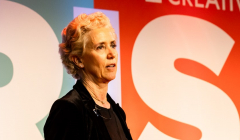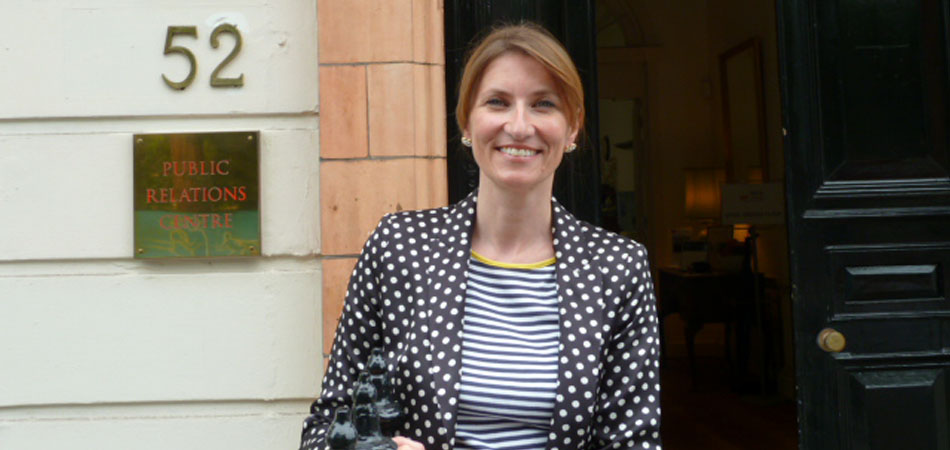
Diageo CMO on progressive media, AI and inclusivity
Speaking at the Creative Equals Rise conference, Cristina Diezhandino, Chief Marketing Officer at Diageo, lifted the lid on the brand's progressive marketing journey
CEO of the Chartered Institute of Public Relations


Tom Holmes talks to Jane Wilson, CEO of the Chartered Institute of Public Relations, Europe's largest network of PR professionals and Board member of Scottish Youth Theatre.
Jane is also a member of the Institute of Directors, a member of the PR Guild and a Fellow of the RSA. She is a committee member of the Prince’s Trust Women’s Leadership Group and a Trustee of Iprovision, the CIPR’s benevolent fund.
Jane Wilson : Reporting to the CIPR Executive Board and Council, and with around 30 staff, I am responsible for the delivery of all the products and services that we provide to over 9000 members and many professionals outside membership. Beyond this operational activity I also have responsibility for ensuring good governance of the institute and its code of conduct as well as being a regular spokesperson for the CIPR and the profession.
Jane Wilson : I’ve always believed that strong communication skills are vital in any leadership role. Working in corporate communications and as a consultant, I saw first-hand how different leadership styles work with different audiences from investors to the media and employees. I’ve tried to take the best of what I experienced with me as I’ve moved into a CEO role myself. In this particular role, I think it makes a huge difference that I’ve actually done the type of jobs that our members have and can relate to them and their professional needs. So, when I am asked to talk as an industry expert, this means I bring not just the office I hold but my years of industry experience to the conversation.
Jane Wilson : I think there have been three major changes; the importance of reputation to large organisations, technological advances and the rapid evolution of the media landscape.
Improvements in connectivity and technology have increased the opportunities for individuals to build and engage online social networks. This means that public relations is now perhaps for the first time doing what it says on the tin and engagement in social media is both a risk and an opportunity for organisational communications.
This rapid evolution of media is changing the way we consume information and forcing a change on the practice of public relations. The challenge and the opportunity facing public relations is to bridge the gap between the new media and the old – to enable organisations to build relevance and reputation in a more dynamic media environment, while recognising the crucial role that journalism still plays in society.
In the coming years, the increased professionalism among practitioners and increased sophistication in practice – particularly in terms of measurement – will consolidate the rise of public relations and ensure it remains relevant among decision makers and strategists.
Jane Wilson : Social media is about curated content, conversations and relationship building, presenting us with an opportunity to extend the reach of our content directly to our audience. This is public relations – it is what we have always done. But the rise and rise of social media means traditional media relations, while still relevant, is no longer the sum and the stereotype of most public relations activity.
Jane Wilson : The CIPR Social Media Panel is a core group of members dedicated to developing a leadership role within the CIPR and the profession, pushing new frontiers of practice and thanks chiefly to the work of that group, this is the area where we have made greatest strides and have had most impact in the last year or so.
We offer training through our workshop programme and knowledge sharing through our Social Summer series and regular conferences and events. We have published “Share This” – the social media handbook for the PR Professional which has become an Amazon bestseller in a matter of weeks. And importantly, we practice what we preach and use digital channels to engage members and non-members in the life and work of the CIPR.
Jane Wilson : The blurring of where campaigns sit has increased as the disciplines of marketing and advertising converge on public relations. PR has an opportunity to take a lead, intellectually, as reputation and relationships become increasingly important for organisations. Often it’s the case that it’s horses for courses and each organisation must use the tools that best suit their needs. The important thing is that this can now be done in a far more collaborative way. Combining say the data driven side of marketing with, the qualitative aspects of public relations would help organisations present a compelling case and build durable relationships that enable their objectives to be met.
Jane Wilson : PR is an important but in number terms a relatively small profession – approximately 50,000-60,000 people. To give that some context the construction industry sustains over a million jobs and 1.3 million people work for the NHS. It is not particularly well understood, even by some who work in it.
The CIPR is committed to working with other bodies representing communications disciplines and sectors and believes that the profession is often better represented through strategic alliances that can give public relations a powerful voice. In a business context it is also important to look beyond our near neighbours in similar disciplines to other areas such as strategy, finance, HR and the legal professions.
Jane Wilson : We engage with government directly, and with a timely and well-argued case. This might mean participating in a consultation such as the recent one on a statutory register of lobbyists, giving evidence to Commons or Lords committees or working with the Cabinet Office on skills and professional development for public sector PR professionals. At an international level, we work within the framework of the Global Alliance.
Jane Wilson : As CIPR looks to set its next 3 year strategic plan, some of the issues on our horizon are; keeping ahead of the changing media and technology landscape, ethics and industry self-regulation, the role of reputation – its contribution to organisations and the economy, diversity and the under and over representation of groups in the PR work force and measurement and evaluation.
Jane Wilson : It helps us showcase that public relations is leading the debate on business and organisational communications and allows us to engage with professionals across a number of related disciplines to move practice forward in a meaningful way.
Jane Wilson : Primarily I think it allows to benchmark across borders which in an increasingly global environment is important. With international reach being ever more possible, competition for work is as likely to come from New York or Dubai as it is from London.
Jane Wilson : To see it embrace the changing environments in which public relations, advertising and marketing exist and operate and to lead the way in developing new ways to work together in a collaborative and professional way.
Jane Wilson : CIPR is the largest public relations network in Europe – there is a lot of peer to peer expertise to draw on here. Membership offers professional credibility, access to professional development and public accountability to a professional code of conduct.
Jane Wilson : Making every CIPR product or services accessible to every member regardless of where they are in the UK is one of our key ambitions for the Institute. Around 30% of our members in greater London with most of the rest across the UK and around 5% overseas. We have national and regional groups covering the UK and provide access to training and qualifications in a number of locations across the country. We increasingly provide access to courses and resources online, both live and on demand to satisfy a large geographical spread of membership. We have plans to greatly enhance the CIPR’s offer to meet the needs of a diverse membership.
Jane Wilson : The CIPR has just launched the Equal Access Network, a networking group for practitioners who are affected by or have an interest in issues relating to diversity in employment and representation within public relations.
The CIPR Diversity Working Group recognises diversity as an all-encompassing term that acknowledges and respects differences such as gender, ethnicity, sexuality, socio-economic background, disability, religion/faith and age. In 2010/11 the group undertook a ‘Conversation’ with the PR industry in order to better understand the best way to promote an inclusive culture, raise general awareness of diversity issues and to increase the number of PR practitioners from all backgrounds.
This work has informed the current CIPR Diversity Strategy and the role of the Diversity Working Group moving forward is to advise and oversee the work of the CIPR in the delivery of this strategy.
And on the 7th November we host our Internal Communications Conference 2012.
CIPR Inside 11th annual conference: “Putting Employees First” at the Kia Oval, London.
Looks like you need to create a Creativebrief account to perform this action.
Create account Sign inLooks like you need to create a Creativebrief account to perform this action.
Create account Sign in